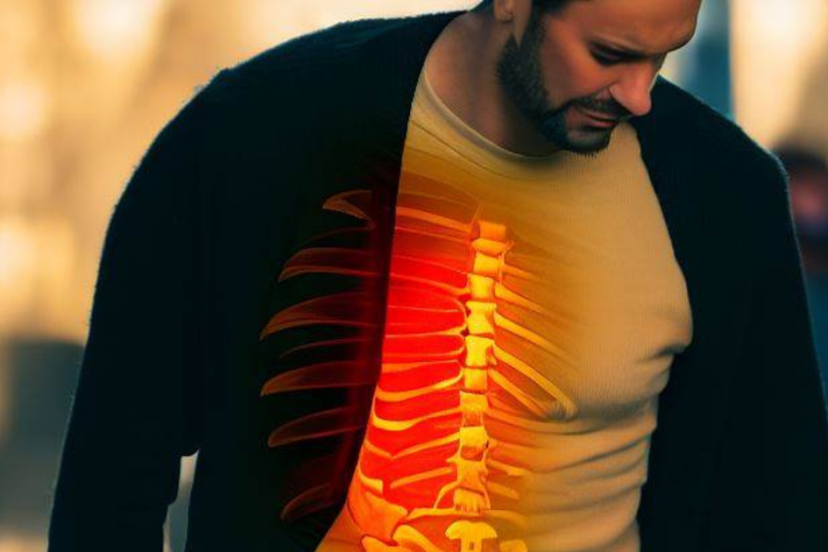Pain around Ribs and Back Symptoms: Understanding and Managing
Anatomy of the Ribs and Back
To understand the potential causes, it is helpful to have a basic understanding of the anatomy involved. The ribs are curved bones that form the chest wall, protecting vital organs such as the heart and lungs. They are connected to the spine at the back and to the sternum (breastbone) at the front. Muscles, ligaments, and nerves in this area support and facilitate movement of the ribcage.
Common Causes of Pain around Ribs and Back Symptoms
Muscular Causes
1. Muscle Strain or Injury:
- Definitions: Muscle strain refers to the stretching or tearing of muscle fibers, while muscle injury encompasses various types of damage to the muscle tissue.
- Causes: Muscle strain or injury can occur due to sudden movements, overexertion, lifting heavy objects, or participating in vigorous physical activities.
- Symptoms: Common symptoms include localized pain, tenderness, swelling, limited range of motion, and muscle stiffness.
- Diagnosis: A medical evaluation, including a physical examination and possibly imaging tests, can help diagnose muscle strain or injury.
- Treatments: Treatment options may include rest, applying ice or heat, taking over-the-counter pain relievers, physical therapy, and avoiding activities that exacerbate the pain.
- Self-Care Treatments: Practicing good posture, incorporating gentle stretching exercises, maintaining a healthy lifestyle, and avoiding further strain can promote healing.
2. Intercostal Muscle Inflammation:
- Definitions: The intercostal muscles are located between the ribs and assist with breathing movements. Inflammation of these muscles can cause chest pain.
- Causes: Intercostal muscle inflammation can result from activities that involve repetitive or forceful twisting or bending of the torso, muscle strain, or respiratory infections.
- Symptoms: Symptoms may include localized chest pain that worsens with movement or deep breathing, tenderness, and difficulty taking deep breaths.
- Diagnosis: A healthcare professional will conduct a physical examination, review your medical history, and may order imaging tests to rule out other conditions.
- Treatments: Treatment options for intercostal muscle inflammation may include rest, pain relief medications, applying heat or cold packs, gentle stretching exercises, and avoiding activities that aggravate the pain.
- Self-Care Treatments: Practicing proper posture, engaging in relaxation techniques, and avoiding activities that strain the intercostal muscles can aid in recovery.
3. Rib Fractures or Bruising:
- Definitions: Rib fractures refer to a break in the rib bones, while rib bruising involves damage to the blood vessels around the ribs.
- Causes: Rib fractures or bruising can occur due to traumatic events, such as a fall, direct impact to the chest, or forceful compression.
- Symptoms: Symptoms include sharp pain, tenderness, difficulty breathing deeply, visible bruising, and swelling in the affected area.
- Diagnosis: A healthcare professional will conduct a physical examination, review medical history, and may order imaging tests, such as X-rays, to confirm the presence of rib fractures or bruising.
- Treatments: Treatment options may include pain management, rest, avoiding activities that strain the ribs, using ice or heat packs, and in severe cases, immobilization with a chest brace or bandages.
- Self-Care Treatments: Following healthcare provider’s instructions, practicing proper posture, maintaining a balanced diet, and engaging in light physical activities as recommended can aid in the healing process.
4. Postural Issues:
- Definitions: Postural issues refer to poor alignment or positioning of the body, leading to stress on the muscles and structures in the chest area.
- Causes: Factors such as prolonged sitting, slouching, improper lifting techniques, and weak core muscles can contribute
to postural issues and chest pain. - Symptoms: Symptoms of postural issues may include aching or dull pain in the chest, upper back, or shoulders, worsened pain with certain positions or activities, and muscle stiffness.
- Diagnosis: A healthcare professional can assess your posture, conduct a physical examination, and discuss your symptoms to determine if postural issues contribute to your chest pain.
- Treatments: Treatment options for postural issues may include improving posture through exercises and stretches that strengthen the core muscles, practicing proper ergonomics, and maintaining good posture during daily activities.
- Self-Care Treatments: Implementing ergonomic adjustments in your workspace, maintaining a proper sitting and standing posture, incorporating regular breaks for stretching, and practicing relaxation techniques can help alleviate chest pain caused by postural issues
5. Costochondritis:
- Definitions: Costochondritis is the inflammation of the cartilage that connects the ribs to the breastbone (sternum).
- Causes: The exact cause of costochondritis is often unknown, but it can result from injury, overuse, respiratory infections, or underlying inflammatory conditions.
- Symptoms: Symptoms typically include sharp, stabbing chest pain that may radiate to the back or abdomen, tenderness or sensitivity around the affected area, and discomfort exacerbated by deep breaths or certain movements.
- Diagnosis: A healthcare professional will perform a physical examination, review your medical history, and may order imaging tests or laboratory tests to rule out other conditions with similar symptoms.
- Treatments: Treatment options for costochondritis may include pain management with over-the-counter nonsteroidal anti-inflammatory drugs (NSAIDs), applying heat or cold packs, gentle stretching exercises, and avoiding activities that worsen the pain.
- Self-Care Treatments: Practicing good posture, using cushions or pillows for support, maintaining a healthy lifestyle, and applying self-care measures recommended by your healthcare provider can help manage the symptoms of costochondritis.
Skeletal Causes:
1. Spinal misalignment:
- Definitions: Spinal misalignment refers to an abnormal positioning or curvature of the spine, which can affect the surrounding structures and cause chest pain.
- Causes: Spinal misalignment can result from poor posture, injury, degenerative conditions, or underlying spinal conditions.
- Symptoms: Symptoms may include localized or radiating chest pain, back pain, limited range of motion, muscle spasms, and discomfort worsened by movement or certain positions.
- Diagnosis: A healthcare professional may perform a physical examination, review medical history, and order imaging tests such as X-rays or MRI scans to assess the spinal alignment and identify any abnormalities.
- Treatments: Treatment options for spinal misalignment may include chiropractic adjustments, physical therapy, pain management techniques, and in severe cases, surgical interventions.
- Self-Care Treatments: Maintaining good posture, practicing exercises that promote spinal alignment and core strength, using proper body mechanics, and avoiding activities that exacerbate the pain can aid in self-care for spinal misalignment.
2. Herniated discs:
- Definitions: A herniated disc occurs when the soft cushioning disc between the vertebrae in the spine ruptures or bulges, potentially compressing nearby nerves and causing chest pain.
- Causes: Herniated discs can result from age-related degeneration, trauma, lifting heavy objects improperly, or repetitive strain on the spine.
- Symptoms: Symptoms may include localized or radiating chest pain, back pain, numbness or tingling in the arms or legs, muscle weakness, and discomfort exacerbated by certain movements or positions.
- Diagnosis: A healthcare professional may conduct a physical examination, evaluate symptoms, and order imaging tests such as MRI or CT scans to confirm the presence of a herniated disc.
- Treatments: Treatment options for herniated discs may include pain management with medications, physical therapy, spinal injections, and in severe cases, surgery.
- Self-Care Treatments: Applying heat or cold packs to the affected area, maintaining proper posture, practicing gentle stretching exercises, and avoiding activities that worsen the pain can be beneficial in self-care for herniated discs.
3. Osteoporosis or osteoarthritis:
- Definitions: Osteoporosis is a condition characterized by weakened and brittle bones, while osteoarthritis is a degenerative joint disease that causes the breakdown of cartilage.
- Causes: Osteoporosis is often age-related or associated with hormonal changes, while osteoarthritis can result from wear and tear, injury, or genetic factors.
- Symptoms: Symptoms may include chest pain, joint pain or stiffness, reduced range of motion, bone fractures (in the case of osteoporosis), and discomfort worsened by movement or weight-bearing activities.
- Diagnosis: A healthcare professional may order bone density tests, X-rays, blood tests, or joint fluid analysis to diagnose osteoporosis or osteoarthritis.
- Treatments: Treatment options for osteoporosis may include medications, lifestyle modifications, calcium and vitamin D supplements, and exercise programs. Osteoarthritis treatment may involve pain management, physical therapy, assistive devices, and in severe cases, joint replacement surgery.
- Self-Care Treatments: Maintaining a balanced diet rich in calcium and vitamin D, engaging in weight-bearing exercises, practicing joint protection techniques, and following recommended treatments and self-care measures can aid in managing osteoporosis or osteoarthritis.
Organ-related Causes:
1. Gallbladder issues:
- Definitions: Gallbladder issues refer to conditions that affect the gallbladder, such as gallstones, inflammation, or infection.
- Causes: Gallbladder issues can result from gallstones blocking the
bile duct, gallbladder inflammation (cholecystitis), or infection (cholecystitis). - Symptoms: Symptoms may include chest pain, particularly in the upper right abdomen, along with nausea, vomiting, fever, jaundice, and discomfort worsened after consuming fatty or greasy foods.
- Diagnosis: A healthcare professional may perform a physical examination, review medical history, and order diagnostic tests such as ultrasound, CT scan, or blood tests to assess the gallbladder and identify any abnormalities.
- Treatments: Treatment options for gallbladder issues may include medication to dissolve gallstones, surgical removal of the gallbladder (cholecystectomy), or other interventions depending on the underlying condition.
- Self-Care Treatments: Following a healthy diet low in fat, avoiding trigger foods, maintaining a healthy weight, and managing stress can help manage symptoms of gallbladder issues. It is important to consult a healthcare professional for proper diagnosis and treatment.
2. Kidney stones or infections:
- Definitions: Kidney stones are hard deposits formed in the kidneys, while kidney infections refer to bacterial infections in the kidneys.
- Causes: Kidney stones can develop when certain substances in the urine crystallize and form solid masses, while kidney infections often result from bacteria entering the urinary tract and reaching the kidneys.
- Symptoms: Symptoms may include chest pain, flank pain (pain on the sides of the back), frequent urination, blood in the urine, fever, chills, and discomfort that may radiate to the lower abdomen or groin.
- Diagnosis: A healthcare professional may conduct a physical examination, review medical history, and order imaging tests (such as CT scan or ultrasound) and urine tests to diagnose kidney stones or infections.
- Treatments: Treatment options for kidney stones may include pain medication, increased fluid intake, dietary changes, and in some cases, procedures or surgery to remove or break down the stones. Kidney infections often require antibiotic treatment to eliminate the infection.
- Self-Care Treatments: Drinking plenty of water to stay hydrated, following a healthy diet, avoiding certain foods that may contribute to stone formation, and practicing good hygiene to prevent urinary tract infections can be helpful in self-care for kidney stones or infections.
3. Pancreatitis or liver conditions:
- Definitions: Pancreatitis refers to inflammation of the pancreas, while liver conditions encompass a range of disorders affecting the liver, such as hepatitis, fatty liver disease, or cirrhosis.
- Causes: Pancreatitis can be caused by gallstones, alcohol abuse, certain medications, or underlying medical conditions. Liver conditions can result from viral infections, excessive alcohol consumption, metabolic disorders, or other factors.
- Symptoms: Symptoms may include chest pain, abdominal pain (in the upper right abdomen for liver conditions), nausea, vomiting, jaundice, loss of appetite, and fatigue.
- Diagnosis: A healthcare professional may perform a physical examination, review medical history, and order blood tests, imaging tests (such as ultrasound or MRI), or specialized tests to diagnose pancreatitis or liver conditions.
- Treatments: Treatment options for pancreatitis may involve pain management, supportive care, dietary modifications, and addressing the underlying cause. Liver conditions may require lifestyle changes, medication, or specific interventions depending on the condition.
- Self-Care Treatments: Following a healthy lifestyle, avoiding alcohol or substances that may further damage the pancreas or liver, managing underlying conditions (such as diabetes or obesity), and adhering to prescribed treatment plans can support self-care for pancreatitis or liver conditions. It is crucial to consult a healthcare professional for proper diagnosis and guidance.
Please note that this response provides general information and should not substitute professional medical advice. It is important to consult a qualified healthcare provider for an accurate diagnosis based on your specific condition. They will be able to provide you with comprehensive medical advice and guidance tailored to your needs.
Identifying Pain around Ribs and Back Symptoms
- Persistent or worsening pain that does not improve with self-care measures
- Difficulty breathing or sharp, stabbing pain
- Fever, chills, or signs of infection
- Numbness or weakness in the limbs
- Abdominal pain accompanied by back pain
- Unexplained weight loss or appetite changes
Self-Care Strategies for Managing Pain around Ribs and Back
1. Rest and Gentle Movement
2. Applying Heat or Cold Therapy
3. Over-the-Counter Pain Relief Options
4. Maintaining Proper Posture and Ergonomics
5. Stress Reduction and Relaxation Techniques
Seeking Professional Medical Advice
Conclusion
FAQs
1. Can stress contribute to pain around the ribs and back?
2. Are there specific exercises that can help relieve pain around the ribs and back?
3. When should I seek medical attention for pain around the ribs and back?
4. Can poor posture contribute to pain around the ribs and back?
5.How long does it take for pain around the ribs and back to heal?
*We may earn a commission from purchases made through our links, at no cost to you. This does not affect our product recommendations. Please see our disclosure to learn more.
![Urban Health Hive]](https://urbanhealthhive.com/wp-content/uploads/2023/05/cropped-cropped-Health_Logo.png)



